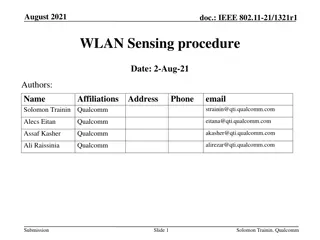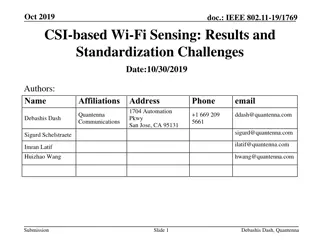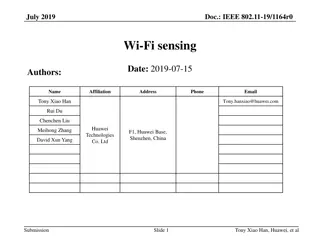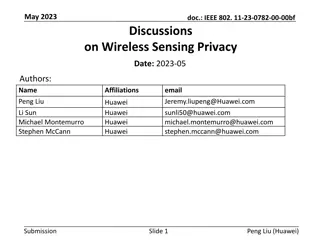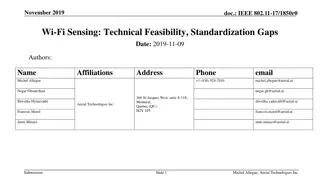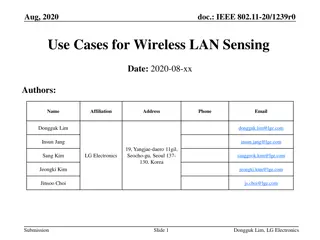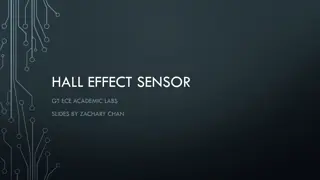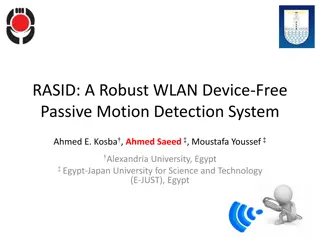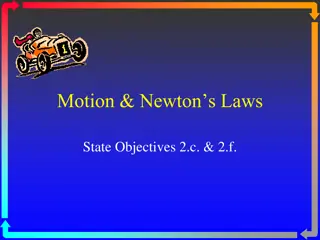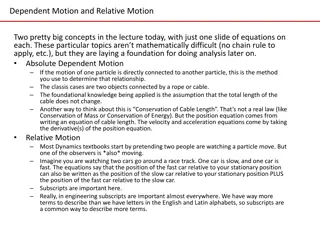Exploring Wi-Fi Sensing for Motion Detection and Beyond
The document discusses the utilization of Wi-Fi signals for sensing various features in a given environment, such as motion, presence, gesture, and more, without assuming the subject carries a Wi-Fi device. It covers applications, technical principles, and a three-phase algorithm for motion detection using STA diversity. The focus is on collaboration, standard support, and next steps for Wi-Fi sensing advancements.
Download Presentation

Please find below an Image/Link to download the presentation.
The content on the website is provided AS IS for your information and personal use only. It may not be sold, licensed, or shared on other websites without obtaining consent from the author. Download presentation by click this link. If you encounter any issues during the download, it is possible that the publisher has removed the file from their server.
E N D
Presentation Transcript
September 2019 Wi-Fi Sensing: Cooperation and Standard Support doc.: IEEE 802.11-19/1416r0 Date: 2019-09-06 Authors: Name Claudio da Silva Affiliations Intel Address Phone email claudio.da.silva@intel.com Carlos Cordeiro Bahar Sadeghi Artyom Lomayev Cheng Chen Ganesh Venkatesan Preston Hunt Submission Slide 1 Claudio da Silva, Intel
September 2019 doc.: IEEE 802.11-19/1416r0 Introduction In our previous contribution to WNG [1], we introduced Wi-Fi sensing, discussed use cases and requirements, and demonstrated technical feasibility. Discussion aligned with that presented in [2]. Other presentations on the topic will be made this week. This presentation extends the discussion in [1] and covers: Background Results of measurement campaigns Need for collaboration in Wi-Fi sensing Standard gaps Conclusions and proposed next steps Submission Slide 2 Claudio da Silva, Intel
September 2019 doc.: IEEE 802.11-19/1416r0 Wi-Fi Sensing Wi-Fi sensing is the use, by one or more STAs, of Wi-Fi signals to detect features of intended subject(s) in a given environment. Features: motion, presence or proximity, gesture, people counting, geometry, velocity, etc. Subject: object, human, animal, etc. Environment: Within a few centimeters/meters of a device, room, house/enterprise, etc. Wi-Fi sensing does not assume that the intended subject carries a device with Wi-Fi functionality. The STA that transmits a Wi-Fi signal may or may not be the same as the STA that performs the Wi-Fi sensing function. Submission Slide 3 Claudio da Silva, Intel
September 2019 doc.: IEEE 802.11-19/1416r0 Wi-Fi Sensing: Examples of Applications Submission Slide 4 Claudio da Silva, Intel
September 2019 doc.: IEEE 802.11-19/1416r0 Using Wi-Fi for Sensing Figures show the amplitude and phase of channel estimates obtained with multiple PPDUs over time (~3 minutes). Each curve corresponds to one PPDU. Top row: no motion. Bottom row: motion in the room (one person randomly walking). Technical principle behind Wi-Fi sensing is to track channel estimates obtained when decoding Wi-Fi packets over time, and to detect/classify changes that indicate an event of interest. Detection of some features require machine learning, but many can be achieved without it. Submission Slide 5 Claudio da Silva, Intel
September 2019 doc.: IEEE 802.11-19/1416r0 Technical Approach To test feasibility and evaluate the need for standard support, we implemented a method that relies solely on STA diversity. Core algorithm makes use of the covariance matrix of multiple channel estimates obtained over time to determine motion in the link. Algorithm has 3 phases Measurement capture Motion detection Sensing algorithm Phase 1: Measurement capture and conditioning Phase 2: Motion detection E-metric Conditioned measurements Covariance estimation Eigen- Likelihood decomposition Phase 3: Sensing algorithm Link 1/STA 1 Logic Link 2/STA 2 Decision Link 3/STA 3 Submission Slide 6 Claudio da Silva, Intel
September 2019 doc.: IEEE 802.11-19/1416r0 Testbed Home Environment We performed extensive measurement campaigns to evaluate the need for collaboration in Wi-Fi sensing. Set up: Wi-Fi networks operating co-channel (5 GHz, channel 44) Client laptop operating in sniffer mode Brand name APs with chipsets coming from different vendors Stationary devices Submission Slide 7 Claudio da Silva, Intel
September 2019 doc.: IEEE 802.11-19/1416r0 Testbed In all experiments here presented, Goal: Detect motion and identify where (e.g., in which room) it happens. For ease of presentation and analysis, only three STAs are considered: STA O, STA PR, and STA B1. Experiments considered: Experiment 1: TX STA diversity, single subject Experiment 2: RX STA diversity, single subject Experiment 3: TX STA and RX STA diversity, multiple subjects For experiments 1 and 2, the following hypotheses are considered: No motion Motion at office only Motion at play room only Motion at bedroom 1 only Submission Slide 8 Claudio da Silva, Intel
September 2019 doc.: IEEE 802.11-19/1416r0 Experiment 1 To exemplify the impact of movement in different rooms to the link, we plot the measured E-metric values for the different hypotheses as a function of time. E-metric: Measure of time variability of the link. Submission Slide 9 Claudio da Silva, Intel
September 2019 doc.: IEEE 802.11-19/1416r0 Experiment 1 With appropriate training/calibration, it is possible to develop statistical classifiers that take the calculated E-metric values over time and make a decision on the presence and location of a subject. predicted 0.9329 No motion Office Bedroom 1 Play room No motion 0.9409 0.0017 0.0262 0.0312 Office 1.127e-4 0.4887 0.4442 0.0670 actual Bedroom 1 1.745e-4 0.2747 0.6941 0.0310 Play room 0.0147 0.1369 0.0795 0.7689 Example Confusion matrix: The system mistakes movement in the play room as movement in bedroom 1 with a probability equal to 0.0795. 0.9688 With one transmitter, it may not be possible to differentiate whether motion is close to the transmitter, close to the receiver, or somewhere along the link. Submission Slide 10 Claudio da Silva, Intel
September 2019 doc.: IEEE 802.11-19/1416r0 Experiment 1 TX STA Diversity Links with the same RX but different TXs likely have different sensing characteristics. In principle, improved performance may be obtained by appropriately combining such links. We call this technique transmit STA diversity. Submission Slide 11 Claudio da Silva, Intel
September 2019 doc.: IEEE 802.11-19/1416r0 Experiment 1 TX STA Diversity As seen below, as expected, the second (black) link has different characteristics from the first (blue) one. Example: The black link allows for accurate detection and classification of motion in bedroom 1. No motion Office Bedroom 1 Play room No motion 0.6353 0 0.3643 0.0004 Office 0 0.6252 0.0069 0.3679 Bedroom 1 0.0510 0.0049 0.8924 0.0517 Play room 0.0001 0.4906 0.0267 0.4826 Submission Slide 12 Claudio da Silva, Intel
September 2019 doc.: IEEE 802.11-19/1416r0 Experiment 1 TX STA Diversity By assuming that the hypotheses are equally likely and that decisions made using each link are conditionally independent, ? ??????|???? 1,???? 2 =? ???? 1|?????? ? ???? 2|?????? ? ?????? ? ???? 1,???? 2 and using a MAP classifier, we fuse the data provided by each link and obtain: No motion Office Bedroom 1 Play room No motion 0.9603 0 0.0393 0.0004 Office 0 0.9265 0.0069 0.0666 Bedroom 1 0.0017 0.0548 0.9416 0.0018 Play room 0.0005 0.2106 0.0263 0.7626 By exploiting TX STA diversity, the average probability of correct classification increases from 0.691 (1 TX) to 0.898 (2 TXs) a relative improvement of 30%. It is important to keep in mind, however, that all links with a common receiver have a common observation point. Additional gains are expected with the use of receive STA diversity. Submission Slide 13 Claudio da Silva, Intel
September 2019 doc.: IEEE 802.11-19/1416r0 Experiment 2 Assume that sensing measurements are now taken by STA B1, as shown in the figure to the left. Because measurements are now taken by a different point (with a different perspective ), results obtained have different characteristics, as shown below. We call this receive STA diversity. No motion Office Bedroom 1 Play room No motion 0.7791 0.2189 0.0004 0.0017 Office 0.0292 0.9682 0.0024 0.0002 Bedroom 1 0 0 0.9640 0.0360 Play room 0 0 0.2529 0.7471 The system now misclassifies movement in the play room as movement in bedroom 1 often. In the first configuration, this error was rarely made. Instead, the most likely error was misclassifying the same movement as movement in the office. Submission Slide 14 Claudio da Silva, Intel
September 2019 doc.: IEEE 802.11-19/1416r0 Experiment 2 RX STA Diversity By employing the same classifier previously formulated, we fuse the data provided by each receiver and obtain: No motion Office Bedroom 1 Play room No motion 0.9992 0.0004 0.0005 0 Office 0.0069 0.9905 0 0.0026 Bedroom 1 0.0001 0 0.9432 0.0566 Play room 0.0004 0 0.0264 0.9732 Avg. Probability Correct Classification 97.6% 88.1% 100.00% 65.6% 50.00% 0.00% 1TX,1RX 2TX,1RX 2TX,2RX Submission Slide 15 Claudio da Silva, Intel
September 2019 doc.: IEEE 802.11-19/1416r0 Experiment 3 Using the same devices and configurations as before, we also evaluated the case when 2 people were present in the subject environment. New sets of hypotheses: No motion Motion at office only Motion at play room only Motion at bedroom 1 only Motion at both office and play room Motion at both office and bedroom 1 Motion at both play room and bedroom 1 Submission Slide 16 Claudio da Silva, Intel
September 2019 doc.: IEEE 802.11-19/1416r0 Experiment 3 When STA O is the sensing receiver No O PR B1 O + PR O + B1 PR + B1 No 1 0 0 0 0 0 0 O 0 0.4989 0.0134 0.0009 0.2131 0.1465 0.1272 PR 0 0.0066 0.9783 0.0002 0.0061 0.0026 0.0061 B1 O + PR 0 0.0003 0.0031 0.9881 0 0.0008 0.0076 0 0.3215 0.0158 0.0002 0.3642 0.1099 0.1882 O + B1 0 0.1558 0.0004 0.0011 0.0359 0.5992 0.2077 PR + B1 0 0.1855 0.0109 0.0077 0.1267 0.2988 0.3703 When STA B1 is the sensing receiver No O PR B1 O + PR O + B1 PR + B1 No 0.9998 0.0002 0 0 0 0 0 O 0 1 0 0 0 0 0 PR 0 0 0.9747 0.0133 0.0104 0 0.0016 B1 O + PR 0 0 0.0047 0.3344 0.2480 0.2054 0.2074 0 0 0.0019 0.1240 0.7726 0.0690 0.0323 O + B1 0 0 0 0.1156 0.1938 0.4435 0.2470 PR + B1 0 0 0.0001 0.1130 0.0728 0.1394 0.6747 Submission Slide 17 Claudio da Silva, Intel
September 2019 doc.: IEEE 802.11-19/1416r0 Experiment 3 The data in the previous slide shows a great example of RX STA diversity. When STA O is the sensing receiver, the system has difficulty in distinguishing hypotheses that include motion in the office. When the sensing receiver is STA B1, the system has difficulty in distinguishing hypotheses that include motion in bedroom 1. By combining data obtained with two receivers, performance is improved: Avg. Probability Correct Classification 87.1% 100.00% 71.4% 51.6% 50.00% 0.00% 1TX,1RX 2TX,1RX 2TX,2RX Improvement obtained with TX STA and RX STA diversity in this more complex application was larger than before. For example, relative improvement of the 2TX,2RX case over the 1TX,1RX case was about 70%, while in experiment 2 was about 50%. Submission Slide 18 Claudio da Silva, Intel
September 2019 doc.: IEEE 802.11-19/1416r0 Experiment 3 To gain insight into the impact of the number of STAs in sensing performance, we repeated experiment 3 with 4 devices. The new station is located in bedroom 2 (STA B2). As shown below, TX STA and RX STA diversity is very important in sensing applications similar to the one considered here (wide coverage, unknown number of subjects). Avg. Probability Correct Classification 99.2% 95.3% 100.00% 90.00% 82.7% 80.00% 70.00% 4TX,1RX 4TX,2RX 4TX,3RX Submission Slide 19 Claudio da Silva, Intel
September 2019 doc.: IEEE 802.11-19/1416r0 Summary: STA Diversity in Wi-Fi Sensing For a large number of Wi-Fi sensing applications, STA diversity in transmission and reception is key. Ability to characterize the environment from multiple points-of-view, focal points Better understanding of the environment and subjects Sense the environment at positions that are potentially closer to subject Improve coverage Lack of knowledge about subject s position Increase robustness to poor geometry More observations necessary to, for example, differentiate multiple subjects and allow for subject tracking Submission Slide 20 Claudio da Silva, Intel
September 2019 doc.: IEEE 802.11-19/1416r0 Need for Standard Support Standard support is necessary to Increase efficiency and reliability of Wi-Fi sensing applications Enable several and diverse use cases As demonstrated in this presentation, Wi-Fi sensing may be improved with TX STA and RX STA diversity, which requires standard support. Other sensing- related aspects that require standard support include Negotiation of sensing parameters and schedule Transmission characteristics of PPDUs used for sensing Power save (e.g., not rely on the opportunistic reception of packets) Protocol flow that efficiently supports unique and fundamental characteristics of Wi-Fi sensing Submission Slide 21 Claudio da Silva, Intel
September 2019 doc.: IEEE 802.11-19/1416r0 Conclusions and Next Steps There is much interest in the industry on Wi-Fi sensing. In this presentation, we showed that standard support is necessary for Wi-Fi sensing. We recommend the creation of a TIG at this session (and possibly a Study Group in November) to advance Wi-Fi sensing by means of Identifying Wi-Fi sensing use cases and applications of interest Identifying technical gaps in 802.11 that would have to be addressed to efficiently and reliably support Wi-Fi sensing Raising awareness and understanding of a potential study group Submission Slide 22 Claudio da Silva, Intel
September 2019 doc.: IEEE 802.11-19/1416r0 SP Would you support the creation of a TIG on Wi-Fi sensing? Yes No Abstain Submission Slide 23 Claudio da Silva, Intel
September 2019 doc.: IEEE 802.11-19/1416r0 References [1] "Wi-Fi sensing: Usages, requirements, technical feasibility and standards gaps," doc. IEEE 802.11-19/1293r0. [2] "Wi-Fi sensing," doc. IEEE 802.11-19/1164r0. Submission Slide 24 Claudio da Silva, Intel







